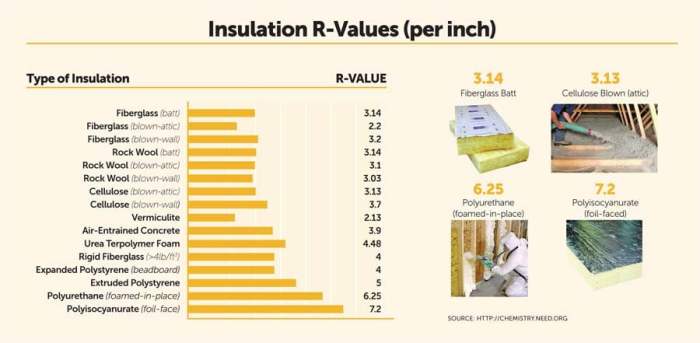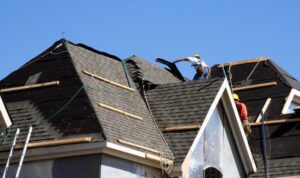Exploring the world of roof insulation materials comparison unveils a wealth of information that can help homeowners make informed decisions about their insulation needs. From understanding the different types of materials to evaluating their cost-effectiveness and environmental impact, this guide covers it all.
As we delve deeper into the specifics of each insulation material and their unique characteristics, readers will gain valuable insights into choosing the right option for their roofing projects.
Types of Roof Insulation Materials

Roof insulation is crucial for maintaining energy efficiency and comfort in a building. There are various types of roof insulation materials available in the market, each with unique properties and benefits. Let's explore some common options:
Fiberglass Insulation
Fiberglass insulation is a popular choice for roof insulation due to its affordability and effectiveness. It consists of fine glass fibers and is known for its high R-value, which measures thermal resistance. Fiberglass insulation is easy to install and widely available in rolls or batts.
Cellulose Insulation
Cellulose insulation is made from recycled paper products treated with fire-retardant chemicals. It offers excellent thermal performance and is environmentally friendly. Cellulose insulation is blown or sprayed into place, filling gaps and creating a seamless barrier against heat transfer.
Foam Board Insulation
Foam board insulation, also known as rigid foam, is a lightweight and durable option for roof insulation. It provides high R-values and is resistant to moisture, making it ideal for humid climates. Foam board insulation can be cut to fit and installed using adhesive or mechanical fasteners.
Spray Foam Insulation
Spray foam insulation is a versatile option that expands upon application, filling cracks and crevices to create a tight seal. It offers superior thermal performance and can help improve indoor air quality by reducing air infiltration. Spray foam insulation requires professional installation due to the specialized equipment involved.These different types of roof insulation materials offer varying levels of thermal resistance and installation methods.
Choosing the right insulation for your roof depends on factors such as budget, climate, and desired energy efficiency. Consider consulting with a professional to determine the best option for your specific needs.
Cost Comparison
When it comes to choosing roof insulation materials, cost is a significant factor to consider. The initial cost of the material, as well as long-term cost-effectiveness, plays a crucial role in decision-making. Let's delve into a detailed cost analysis of different roof insulation materials and explore the factors influencing their costs.:The cost of roof insulation materials can vary depending on factors such as the type of material, R-value, thickness, and the size of the area to be insulated.
Additionally, the installation process and labor costs can also impact the overall expense. It's essential to consider both the upfront cost and long-term savings to determine the most cost-effective option for your specific needs.
Fiberglass Insulation
Fiberglass insulation is one of the most commonly used materials due to its affordability. The cost of fiberglass insulation typically ranges from $0.50 to $1.50 per square foot. While it may have a lower upfront cost, it is essential to consider its R-value and long-term energy savings to evaluate its overall cost-effectiveness.
Spray Foam Insulation
Spray foam insulation tends to be pricier than fiberglass, with costs ranging from $1.50 to $3.00 per square foot. However, its high R-value and superior air sealing properties can result in significant energy savings over time. It is crucial to weigh the initial investment against the long-term benefits when considering spray foam insulation.
Reflective Insulation
Reflective insulation, such as radiant barriers, is another option to consider. The cost of reflective insulation can vary widely, depending on the specific product and installation requirements. While it may have a higher upfront cost compared to other materials, its ability to reflect heat can lead to energy savings in warmer climates.
Additonal Expenses
In addition to the cost of the insulation materials, it's essential to factor in any additional expenses associated with the installation process. These may include labor costs, equipment rentals, and any preparatory work needed to ensure proper insulation. Be sure to obtain detailed quotes and consider the full scope of expenses when calculating the overall cost of insulating your roof.
Environmental Impact
Roof insulation materials play a crucial role in reducing energy consumption and greenhouse gas emissions. Evaluating the environmental impact of these materials is essential to making sustainable choices for your home.When comparing the environmental sustainability of various roof insulation materials, factors such as energy efficiency, recyclability, and eco-friendliness come into play.
By considering these aspects, we can determine how each material contributes to reducing carbon footprint and overall environmental impact.
Energy Efficiency and Carbon Footprint Reduction
When it comes to reducing carbon footprint, the energy efficiency of roof insulation materials is a key factor to consider. Materials such as spray foam insulation and rigid foam boards provide high levels of insulation, helping to reduce the energy needed to heat or cool a building.
This results in lower energy consumption and reduced greenhouse gas emissions, making these materials environmentally friendly choices.
Recyclability and Eco-Friendliness
Another important aspect to consider is the recyclability and eco-friendliness of roof insulation materials. Materials like cellulose insulation, made from recycled paper products, and wool insulation, sourced from natural fibers, are biodegradable and environmentally sustainable options. These materials can be recycled or safely disposed of at the end of their lifespan, minimizing environmental impact.
Certifications and Standards
Certifications such as the GREENGUARD certification or ENERGY STAR label indicate the environmental impact of roof insulation materials. These certifications ensure that the materials meet specific standards for energy efficiency and environmental sustainability, helping consumers make informed decisions when choosing insulation materials for their homes.
Performance and Durability

When it comes to roof insulation materials, understanding their performance and durability in various conditions is crucial for making an informed decision.
Weather Resistance
Different roof insulation materials exhibit varying levels of performance in different weather conditions. For instance, fiberglass insulation remains effective in both hot and cold climates, while cellulose may compact in humid environments, reducing its efficiency.
Durability and Longevity
In terms of durability, materials like fiberglass and spray foam are known for their longevity compared to cellulose. Fiberglass insulation can last for decades without losing its effectiveness, while spray foam provides a tight seal that prevents air leakage over time.
Resistance to Moisture, Mold, and Pests
Fiberglass insulation is resistant to moisture, mold, and pests, making it a popular choice for homeowners. Cellulose, on the other hand, may be susceptible to mold growth if exposed to moisture. Spray foam insulation provides an effective barrier against moisture and pests, reducing the risk of damage to the roof structure.
Real-Life Scenarios
In real-life scenarios, the performance of insulation materials can significantly impact energy efficiency and comfort levels in a home. For example, during extreme weather conditions, such as heatwaves or cold spells, the choice of insulation material can determine how well the indoor temperature is regulated and how much energy is consumed for heating or cooling.
Final Summary

In conclusion, the comparison of roof insulation materials serves as a valuable resource for anyone looking to enhance the efficiency and sustainability of their home. By weighing factors like cost, performance, and environmental impact, individuals can make well-informed choices that benefit both their households and the planet.
FAQ Compilation
Which roof insulation material offers the highest R-value?
Foam board insulation typically has the highest R-value among roof insulation materials.
Are cellulose insulation materials environmentally friendly?
Cellulose insulation is considered eco-friendly as it is made from recycled paper materials.
Do all roof insulation materials require professional installation?
While some materials like fiberglass may require professional installation for optimal results, others like foam board can be installed by homeowners with some DIY skills.
How do I determine the long-term cost-effectiveness of roof insulation materials?
Consider factors such as energy savings, durability, and maintenance requirements to gauge the long-term cost-effectiveness of different insulation materials.
Are there any government certifications for eco-friendly roof insulation materials?
Look for certifications like ENERGY STAR or LEED to identify environmentally sustainable roof insulation materials.












